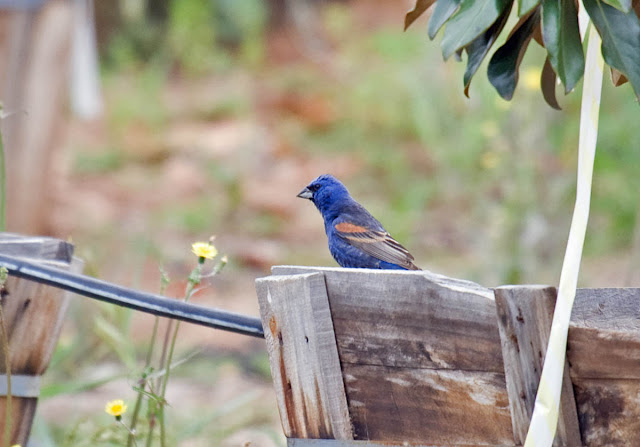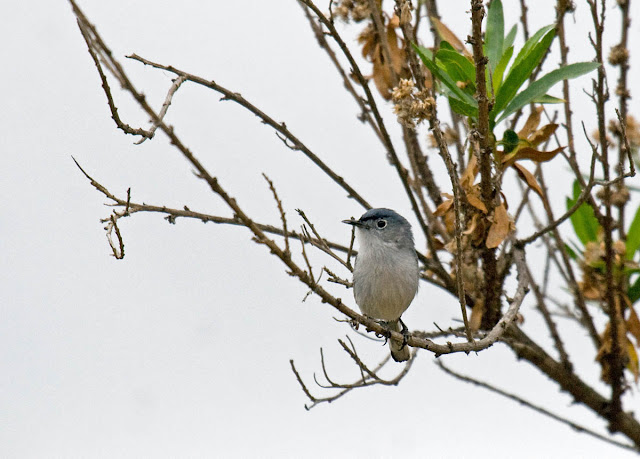In April I wrote a little Site Guide to the
San Dieguito River Park--Coast to Crest Trail. I visited again at the end of May. This time I only walked the trail from the Old Coach Trail Parking Lot. This is east of I-15 (Pomerado Rd exit) on Highland Valley Rd about 2.4 miles. [Enter 13982 Highland Valley Rd, Escondido, California into your GPS navigation app to get close.]
The parking lot is in the middle of a palm tree nursery. The riparian area is across the road, but the water--via irrigation--is in the nursery. Thus, many birds are along both sides of the road flying back-and-forth.
The trail from the parking lot leads northeast along the edge of the nursery, then crosses Highland Valley Road. The trail goes right and left (see sign, below). I first turn left (toward Mule Hill) and follow the trail across a low walkway and enter the riparian (the only place the trail really does so). Just check the birds in this section, and when you reach the dry grass with no birds, go back and take the trail to the right (toward Raptor Ridge) this time.
 |
| From this sign I go left a few hundred feet, then I come back and walk about a mile to the right. |
Some day I would like to walk all the way to the Raptor Ridge Viewpoint. However, it is a comfortable mile to a eucalyptus grove. That's where I've turned back on two visits now. The out-and-back walk, watching birds and taking photos, took me 2 hours this last visit. This grove has nesting Western Kingbirds and Bullock's Orioles. But that's jumping to the end of the story.
First you start right in the parking lot and walk NE along the edge of the palm tree nursery. Birds in the nursery include summering Pacific-slope Flycatchers, Blue Grosbeaks, Hooded Orioles, and many more.
 |
| Blue Grosbeak. Highland Valley Road, Escondido, California. May 30, 2016. Greg Gillson. |
Cross the road (carefully--you can activate a flashing light at the crossing to warn traffic, but that guarantees nothing, as you know). Then you enter a wide riparian area. This has perhaps the most birds of the route, just across the street from the palm tree nursery. Yellow Warblers, Common Yellowthroats, Black-headed Grosbeaks, House Wrens, Bell's Vireos, and Yellow-breasted Chats are summer breeders. Year-long residents include Mourning Doves, Common Ground-Doves, Song Sparrows, Bewick's Wrens, Downy Woodpeckers, Nuttall's Woodpeckers, American Kestrels, Red-shouldered Hawks and more. It really helps to know your bird songs and calls, as the habitat is quite thick, and one is reminded to stay on the trails.
 |
| Downy Woodpecker. |
 |
| Common Ground-Dove. |
 |
| Yellow-breasted Chat. |
 |
| Red-shouldered Hawk. |
After the first quarter mile the trail the trail pulls away from the willow tangle and hugs the bottom of the dry rocky hill.
You still have wetland birds on the left (Yellow Warbler, Black-headed Grosbeak), but chaparral birds on the right (California Towhee). As you cross under the high-tension power lines listen for Rock Wrens and Canyon Wrens on the cliffs above.
 |
| Blue-gray Gnatcatcher |
As you walk along the drier parts of the trail there are a few scattered live-oaks and you pick up Ash-throated Flycatchers, Phainopeplas, and Greater Roadrunners.
 |
| Greater Roadrunner |
 |
| A tiny little butterfly--a Lupine Blue. |
This is a nice flat wide dirt trail. You share it with bicyclists and joggers, but it is not crowded. And there's lots of birds here--those that frequent both riparian and chaparral habitats.













No comments:
Post a Comment
I really want to hear from you! I've changed settings (again) in order to try to make commenting easier without opening it up to spammers. Please note, however, that comments to posts older than 14 days will be moderated. Thank you.